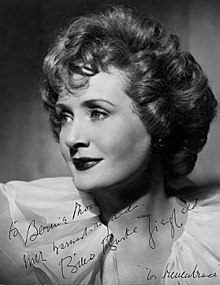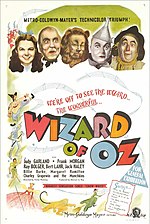Billie Burke
Billie Burke | |
|---|---|
 c. 1942 | |
| Born | Mary William Ethelbert Appleton Burke August 7, 1884 |
| Died | May 14, 1970 (aged 85) Los Angeles, California, U.S. |
| Cause of death | Natural causes |
| Occupation | Actress |
| Years active | 1903–1960 |
| Spouse | Florenz Ziegfeld (m.1914–1932; his death) |
| Children | Patricia Ziegfeld Stephenson |
Mary William Ethelbert Appleton "Billie" Burke (August 7, 1884 – May 14, 1970) [1] was an American actress. She is primarily known to modern audiences as Glinda the Good Witch of the North in the musical film The Wizard of Oz. She was nominated for an Academy Award for her performance as Emily Kilbourne in Merrily We Live. She was also the wife of Florenz Ziegfeld, Jr., of Ziegfeld Follies fame, from 1914 until his death. Her voice was unique in intonation.
Early life
Known as Billie Burke, she toured the United States and Europe with her father, William (Billy) Burke, a singer and clown, who worked for the Barnum & Bailey Circus. Her family ultimately settled in London where she attended plays in the West End. In 1903 she began acting on stage, making her debut in London in The School Girl.[2] Other London shows included The Duchess of Dantzic (1903) and The Blue Moon (1904). She eventually returned to America to star in Broadway musical comedies.
Career
Burke went on to play leads on Broadway in Mrs. Dot,[3] Suzanne,[4] The Runaway, The "Mind-the-Paint" Girl, and The Land of Promise from 1910 to 1913, along with a supporting role in the revival of Sir Arthur Wing Pinero's The Amazons. There she caught the eye of producer Florenz Ziegfeld, marrying him in 1914. In 1916, they had a daughter, Patricia Ziegfeld Stephenson (1916–2008).[5] Burke was quickly signed for the movies, making her film debut in the title role of Peggy (1916). She continued to appear on the stage, and sometimes she starred on the screen. She loved the stage more than movie-business, not only because it was her first love, but also because it allowed her to have speaking parts (impossible in silent movies). But when the family's savings were wiped out in the Crash of 1929, she had no choice but to return to the screen. [citation needed]

In 1932, Burke made her Hollywood comeback, starring as Margaret Fairfield in A Bill of Divorcement, directed by George Cukor. (she played Katharine Hepburn's mother in the film, which was Hepburn's debut). Despite the death of Florenz Ziegfeld during the film's production, she resumed filming shortly after his funeral.
In 1933, Burke was cast as Millicent Jordan, a scatterbrained high-society woman hosting a dinner party in the comedy Dinner at Eight, directed by George Cukor, co-starring with Lionel Barrymore, Marie Dressler, John Barrymore, Jean Harlow and Wallace Beery. The movie was a great success, and revived her career. She subsequently starred in many comedies and musicals, typecast as a ditzy, fluffy and feather-brained upper-class matron with her high-pitched voice.
In 1936, MGM filmed a sanitized biopic of Florenz Ziegfeld (The Great Ziegfeld), a film that won Academy Awards for Best Picture and Best Actress (Luise Rainer as Ziegfeld's common-law wife, Anna Held). William Powell played Flo Ziegfeld and Myrna Loy played Burke.
In 1937 Burke appeared in the first of the Topper films, about a man haunted by two socialite ghosts (played by Cary Grant and Constance Bennett), in which she played the twittering and daffy Clara Topper. Her performance as Emily Kilbourne in Merrily We Live (1938) resulted in her only Oscar nomination. In 1938 she was chosen to play Glinda the Good Witch of the North, in the musical The Wizard of Oz (1939), directed by Victor Fleming, with Judy Garland. She had worked on a Garland film, Everybody Sing, in which she played Judy's histrionically hysterical actress-mother. Another successful film series followed with Father of the Bride (1950) and Father's Little Dividend (1951), both directed by Vincente Minnelli and starring Spencer Tracy, Joan Bennett, and Elizabeth Taylor.
Burke wrote two autobiographies, both with Cameron Van Shippe, With a Feather on My Nose (Appleton 1949) and With Powder on My Nose (Coward McCann, 1959).
Radio and television

On CBS Radio, The Billie Burke Show was heard on Saturday mornings from April 3, 1943 until September 21, 1946. Sponsored by Listerine, this situation comedy was initially titled Fashions in Rations during its first year. Portraying herself as a featherbrained Good Samaritan who lived "in the little white house on Sunnyview Lane," she always offered a helping hand to those in her neighborhood. She worked often in early television, appearing in the short-lived sitcom Doc Corkle (1952). She was a guest star on several TV and radio series, including Duffy's Tavern.
On television, Burke starred in her own talk show, At Home With Billie Burke, which ran on the DuMont Television Network from June 1951 through the spring of 1952. She was one of the first female talk show hosts, after the hostesses of the earlier DuMont series And Everything Nice (1949–50) and Fashions on Parade (1948–49) which both included some talk show segments.[6][7][8]
Burke tried to make a comeback on the New York stage. She starred in two short-lived productions: This Rock and Mrs. January and Mr. Ex. Although she got good reviews, the plays did not. She appeared in several plays in California as well, although her mind became clouded, and she had trouble remembering lines. In the late 1950s, her failing memory led to her retirement from show business, although her explanation for that was, "Acting just wasn't any fun anymore."
Burke's last screen appearance was in Sergeant Rutledge (1960), a Western directed by John Ford.
Personal life

Burke resided in Beverly Hills, California.[9] She died in Los Angeles of natural causes on May 14, 1970, at the age of 85 and was interred at Kensico Cemetery, Valhalla, Westchester County, New York, survived by her daughter, Patricia, and four grandchildren.[10]
Legacy
For many years Burke's framed photo was displayed above the exit staircase at New York's Ziegfeld Theatre, but it vanished after renovations. However, an opening night program, bearing a picture of her, from her 1912 triumph The Mind The Paint Girl (Sir Arthur Wing Pinero) is still displayed in the lobby of the Lyceum Theatre in New York City. A park in the New York City suburb of Hastings on Hudson, New York, is named the Burke Estate.
Radio

- The Ziegfeld Follies of the Air – 1932
- Doubting Thomas - 1935
- Good News of 1939 – 1938
- The Rudy Vallee Hour – 1939
- The Gulf Screen Guild Theater – 1939
- The Rudy Vallee Sealtest Show – 1940–41
- The Pepsodent Show – 1941
- The Billie Burke Show – 1943–1946
- Duffy's Tavern – 1944
- The Sealtest Village Store – 1944
- Mail Call – 1944
- The Charlie McCarthy Show – 1944–47
- Tribute to Ethel Barrymore – 1945
- The Rudy Vallee Show – 1945
- Show Stoppers – 1946
- The Danny Kaye Show – 1946
- WOR 25th Anniversary – 1947
- Your Movietown Radio Theatre – 1948
- The Eddie Cantor Pabst Blue Ribbon Show – 1948
- Family Theater – 1948–52
- This Is Show Business – CBS-TV, 1949
- The Martin and Lewis Show – 1949
- The Bill Stern Colgate Sports Newsreel – 1949
- Stagestruck – 1954
- Biography in Sound – 1955–56
Broadway

- My Wife – 1907
- Love Watches – 1908
- Mrs. Dot – 1910
- Suzanne – 1910
- The Philosopher in the Apple Orchard – 1911
- The Runaway – 1911
- The Amazons – 1913
- The Land of Promise – 1913
- Jerry – 1914
- The Rescuing Angel – 1917
- A Marriage of Convenience – 1918
- Caesar's Wife – 1919
- The Intimate Strangers – 1921
- Rose Briar – 1922
- Annie Dear – 1924
- The Marquise – 1927
- The Happy Husband – 1928
- Family Affairs – 1929
- The Truth Game – 1930
- Ziegfeld Follies of 1934 – 1934
- Ziegfeld Follies of 1936 – 1936
- This Rock – 1943
- Ziegfeld Follies of 1943 – 1943
- Mrs. January and Mr. X – 1944
Filmography
See also
References
- ^ Obituary Variety, May 20, 1970.
- ^ "The School Girl a Hit". The New York Times, 10 May 1903, accessed 20 February 2011
- ^ Mrs. Ziegfeld: The Public and Private Lives of Billie Burke, p. 50.
- ^ Hampton's magazine, Volume 26, Page 362.
- ^ "Patricia Ziegfeld Stephenson, Daughter of Legendary Broadway Impresario". Jazz News. 2008-04-25. Retrieved 2008-05-11.
- ^ Los Angeles Times, Various issues, 1951-52.
- ^ Paley Center For Media recording.
- ^ Radice, Michael L. Glinda's Ruby Slippers, Manuscript Draft, 2012.
- ^ Mitchell Owens, Legendary Hollywood Stars at Home, Architectural Digest
- ^ "Billie Burke Dead. Movie Comedienne. Billie Burke, Film Comedienne and Once a Stage Beauty, Dies". The New York Times. 1970-05-16. Retrieved 2008-05-11.
Billie Burke, a great Broadway beauty when the century was young and later renowned as a movie comedienne, died last night ...
External links
- Billie Burke at IMDb
- Billie Burke at the Internet Broadway Database
- AllMovie.com
- Billie Burke still photos from several Billie plays and lost Billie silent films Univ. of Washington Sayre collection
- Billie Burke photos Univ. of Louisville Macauley Collection
- Flo Ziegfeld-Billie Burke Papers, 1907-1984, held by the Billy Rose Theatre Division, New York Public Library for the Performing Arts
- Billie Burke Digital Image Gallery, Billy Rose Theatre Division, New York Public Library for the Performing Arts
- Billie Burke Collection, held by the Howard Gotlieb Research Center, Boston University
- Literature on Billie Burke
- Billie Burke at Find a Grave
- 1884 births
- 1970 deaths
- 20th-century American actresses
- Actresses from Washington, D.C.
- Actresses from Beverly Hills, California
- American film actresses
- American musical theatre actresses
- American radio personalities
- American silent film actresses
- American stage actresses
- American television actresses
- Deaths from dementia
- Vaudeville performers
- Burials at Kensico Cemetery

